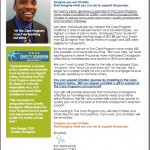How can you constantly be growing, learning, and finding the courage to take chances in your work?
Ask Sarah Mansberger of The Cara Program in Chicago, a regular reader of The Grow Report and winner several months back of my monthly book drawing. Sarah won Tom Ahern’s How to Write Fundraising Materials that Raise More Money at a most opportune time. She had just transitioned into her current position as Communications and Individual Giving Manager for Cara and would be penning her first direct mail appeal the very next day.
That first appeal met with resounding success. But Sarah wasn’t content to let it rest there. She sent me an email asking how the letter might be approved and I suggested that she send it on to Tom himself for one of his famous critiques.
Read Sarah’s communications and letter below:
Dear Mr. Ahern,
I am a big fan of Pamela Grow and she suggested I get in touch with you regarding the 2011 year-end appeal I put together. Let me explain.
I work in the Development department of a Chicago-based npo called The Cara Program. We serve motivated adults affected by homelessness and poverty and work with them to secure and sustain permanent, quality employment and achieve real and lasting success.
Last October I assumed responsibility for our direct mail appeals and communications. Facing the task of preparing my first appeal letter, I threw my name in the hat for Pamela’s giveaway of your book, How to Write Fundraising Materials that Raise More Money. I was the lucky winner! Your book arrived in the mail the day before I was scheduled to begin writing and I could not have been more thrilled. It served as my reference and ‘how to’ throughout the process.
With the appeal out and dollars coming in, I emailed Pamela a copy of the letter for her feedback. Since your book was such a huge help to me, she suggested I reach out to you, too, to get your thoughts.
If you would be so willing, I have included a link to a generic template of the letter for your review. (The actual version that went out was personalized with names and addresses and a good percentage also included ask amounts.) http://www.thecaraprogram.org/sites/default/files/ImagineYouAreCharles.pdf
I would be thrilled, thrilled, thrilled to hear your impressions and any tips you have on how the letter could be improved, more compelling, easier to read, etc.
Thank you for considering my request. Mr. Ahern, and I look forward to hearing from you!
Best,
Sarah Mansberger
And Tom’s response:
Hello, Sarah!
Well, you’ve made it easy for me. Your letter is wonderful!
Charles has a great story to tell — and you told it extremely well. Which, I suspect, you already knew … because no one writes this well by accident.
I do have a few incidental comments that deal with mechanics and visuals.
First, on the visual side.
Your typeface rates very low in readability studies. Colin Wheildon’s research found that sans serif type (what you’re using) is 4 times LESS easy to read than serif type such as Times New Roman. It has to do with what we mostly see during the course of our reading lives. Your letter is physically quite hard to read. Type should be “invisible.”
Also: your line length on the front page is too long for easy skimming. So the eye keeps getting lost, which is frustrating. The perfect line length is usually shy of 70 characters (with spaces). Yours is about 85 with spaces. Small details matter.
Second, on the asking side. You don’t come right out and ask directly until page 2. Most professional direct mail writers will get in an ask within the first couple of paragraphs, then again as the page is turned, then a couple of more times on the back.
Third, there is donor love … but it comes late, after the page is turned. I like to get the donor into the frame very early, and keep them inside the frame (“Thanks to compassionate donors like you…”) throughout the story. Remember: the letter isn’t really about your mission or Charles, the letter is really about making the donor feel special and good.
Finally, you have a matching gift program (always good) but it is kind of side-barred. I’m not sure whether that will hurt response, but I’ve long taken to heart the advice of Aussie star fundraiser, Jonathon Grapsas, who talks about the SMIT: the Single Most Important Thing I have to tell you today. The SMIT for a match is the match, not Charles. Charles should just illustrate the SMIT. As in, “We could do twice as much for people like Charles….”
Hope that helps. My very best, Tom
——
——-
Tom Ahern
What can you learn from Sarah’s appeal? Continue to learn, continue to grow and don’t be afraid to seek out constructive criticism.
How can you learn from more “in-the-trenches” examples? Stay tuned for an innovative learning opportunity to be launched in May!


















 I can’t wait to meet with you personally.
I can’t wait to meet with you personally.
Comments on this entry are closed.